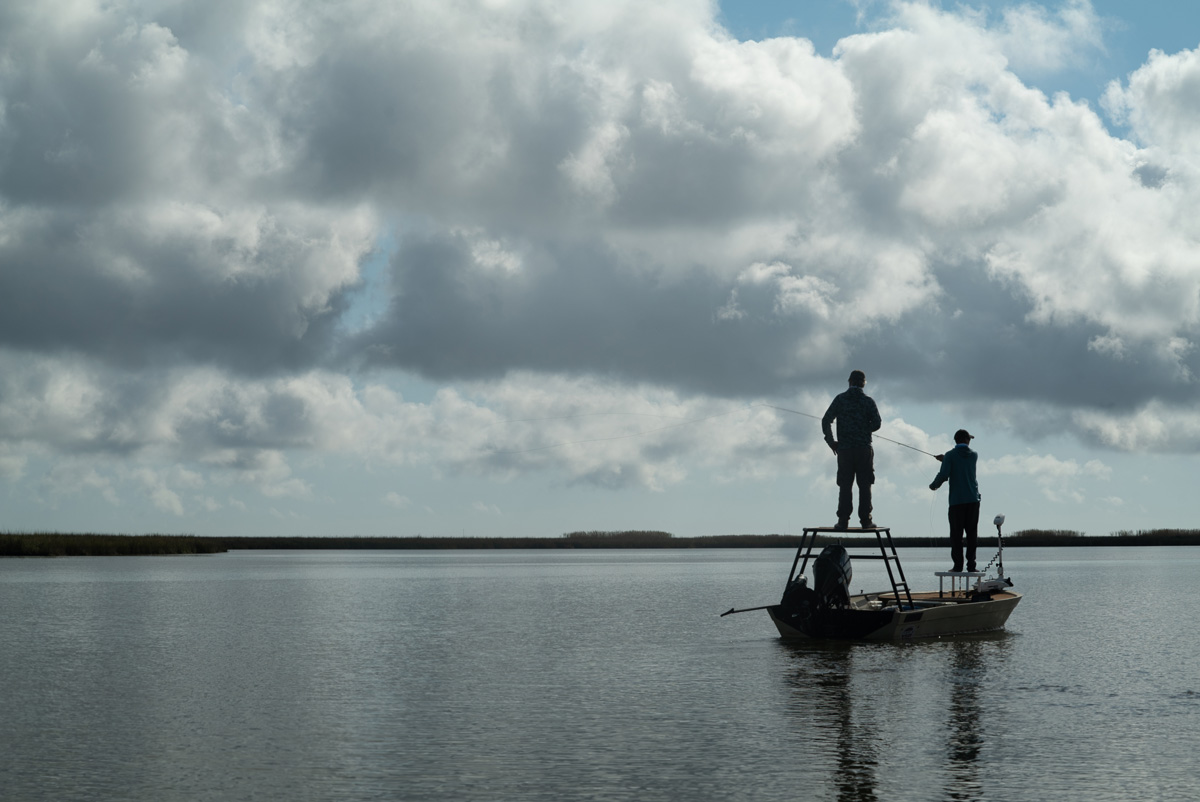Marsh Madness: Despite hiccups, a plan comes together for Louisiana redfish on Sage’s new saltwater gear
by Trey Reid
Louisiana redfish don’t always present the best sight-casting targets. Water clarity, which underpins the hierarchy of marsh variables, is somewhat like black tea. Even when wind, tide, and sunlight create advantageous conditions for sight fishing, visibility still leaves much to be desired.
The Mississippi River’s vast delta is country that’s not sure if it wants to be land or water, where the big river’s fresh water—and the alluvial soils it carries—clash with salt water from the Gulf of Mexico. The higher ground’s oaks and cypress give way to fields of marsh grass pocked by shallow ponds and lakes. Watery ribbons slither through the flat lowlands that rise just inches above sea level. They connect countless pockets of water and become highways for aquatic life. When this maze of earth and water gets stirred up by tides and wind, the result isn’t a sight-fishing dreamland.
But even with stained water to complicate sight fishing—and a fishing buddy who hasn’t quite finished rigging out his new skiff—sometimes a plan comes together.
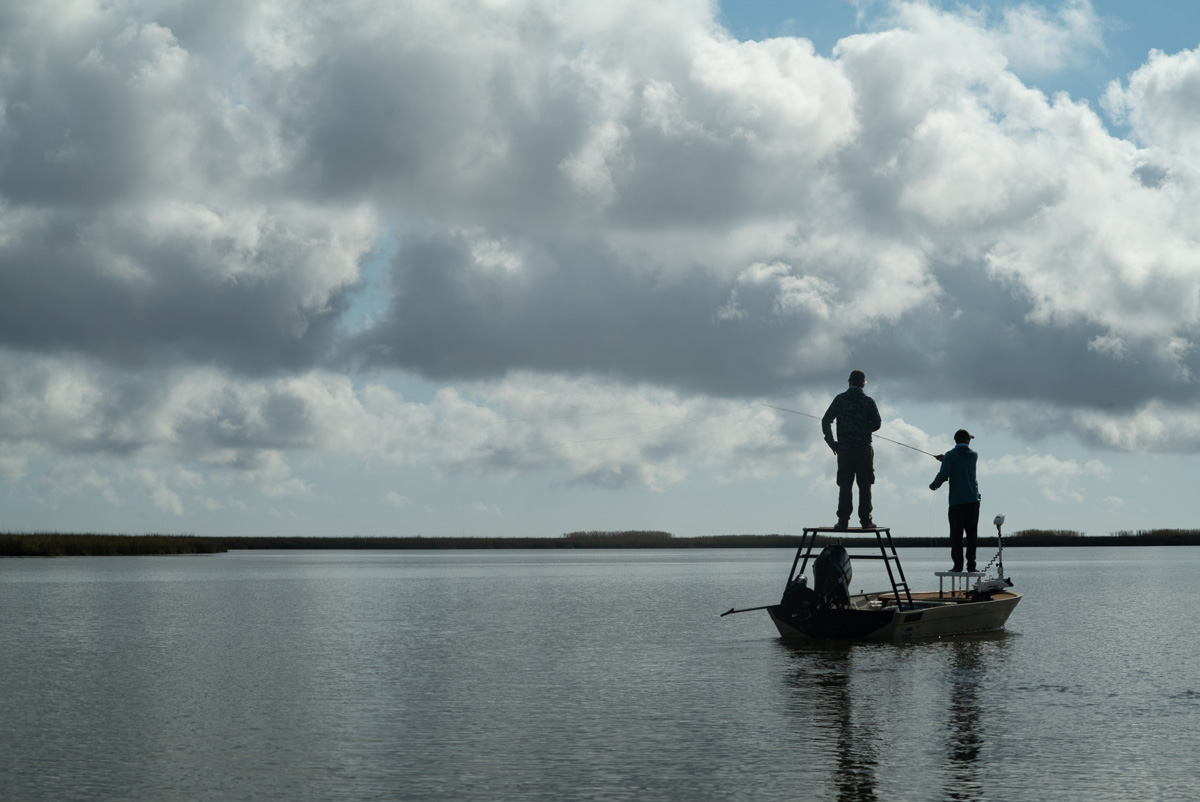 Beyond the Louisiana marsh, this fishing trip took place at the confluence of personal and professional relationships. Multiple friendships and business connections became intertwined, and even with significant logistical considerations, we threaded a needle that resulted in three days of Louisiana fly fishing with the new Sage SALT R8 rods and Sage ENFORCER reels.
Beyond the Louisiana marsh, this fishing trip took place at the confluence of personal and professional relationships. Multiple friendships and business connections became intertwined, and even with significant logistical considerations, we threaded a needle that resulted in three days of Louisiana fly fishing with the new Sage SALT R8 rods and Sage ENFORCER reels.
Being this magazine’s managing editor comes with perks, but it doesn’t necessarily mean Sage was going to hand over a proprietary new saltwater rod a month before its public debut. So it helped to have a friend with a Sage connection and a skiff. We call him Tadpole.
His name is actually Casey Hughes, a Sage Elite Pro and Arkansas fly fishing guide. We’ve mostly fished together for Arkansas trout, usually casting articulated streamers in search of big, piscivorous wild brown trout on the Little Red and White rivers. He’s also a member of my Costa Maya wrecking crew of flats freaks and salty drinkers known as the Loyal Order of Boxfish.
I love Tadpole, but he’s a complicated fellow. He’s a safe, effective, and competent guide, smart and funny, patient and accommodating with clients. But he also marches to his own beat. Time is a constraint he doesn’t always abide. He has strong opinions about everything from fishing methods to fishing apparel and lacks a filter between his brain and tongue. He sometimes jokingly agitates people for sport. I’ve always enjoyed fishing with him and we usually catch fish. When he’s at the helm or on the oars, I’ve always felt safe. But most pertinent to this story, I also go into every adventure with him knowing that our path to success may be circuitous, not adhering to what others might consider a normal plan.
Hughes’ friends Darren Jacober and Jeff Trigg of Three Creeks Outdoor Group represent Sage in the region. Tadpole fishes with them often, and also helps them with product demonstrations for retailers and fishing trips for Three Creeks customers and outdoor-industry colleagues.
Jacober and Trigg had December obligations to bring Texas fly shops up to speed on the new Sage saltwater products, but they also planned a personal fishing trip on the front end of their business travel. Three Creeks’ home base is in central Missouri, and South Louisiana is the closest saltwater destination—and a fisherman could argue that it’s on the way to Houston. It’s also a manageable drive from mine and Hughes’ homes in Arkansas, so when the Sage team reached out to Tail Fly Fishing about the pending release of the SALT R8 and ENFORCER product lines, everything came together for a redfish trip with Sage’s newest saltwater collections.
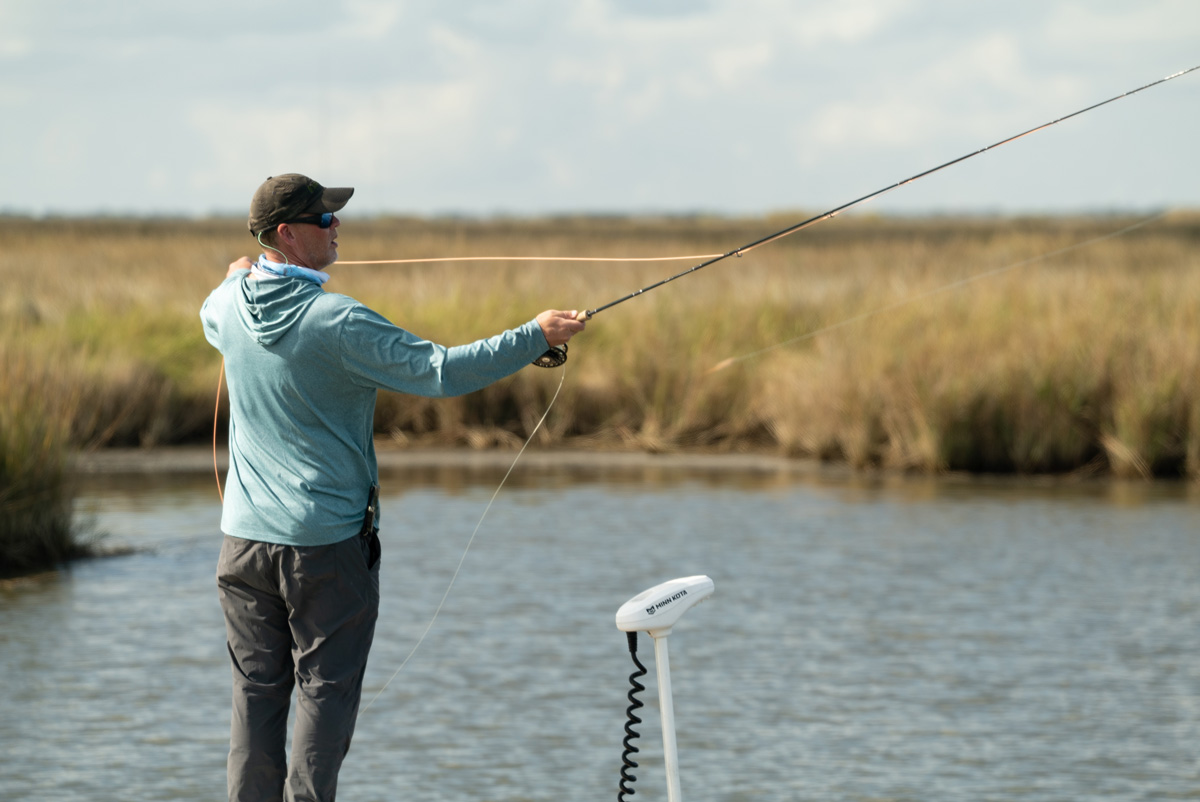 We set out the first morning in identical Hog Island skiffs, heading southwest down a boat channel toward a spot where Jacober and Trigg had found success on past trips. They slipped into a channel that snaked through the marsh toward a small lake. While Tadpole fiddled with his newly installed trolling motor, I stripped line off the ENFORCER reel and made a couple of casts with a 9-weight SALT R8. They were the only two casts I made with it on the first day of fishing.
We set out the first morning in identical Hog Island skiffs, heading southwest down a boat channel toward a spot where Jacober and Trigg had found success on past trips. They slipped into a channel that snaked through the marsh toward a small lake. While Tadpole fiddled with his newly installed trolling motor, I stripped line off the ENFORCER reel and made a couple of casts with a 9-weight SALT R8. They were the only two casts I made with it on the first day of fishing.
The trolling motor’s prop spun for about ten seconds before abruptly stopping. I could blame Tadpole’s last-minute, late-night boat rigging for the problem, but in his defense, a cascading series of logistical complications contributed to the situation. Several weeks before the trip, Tadpole had taken his new skiff to a fabricator for the installation of an aluminum casting deck, but supply-chain issues delayed the project, and the fabricator was still working on it the week before we left for Dulac, Louisiana. Five days before the trip, the fabricator had to step away from the uncompleted deck project for a scheduled knee surgery. Tadpole talked to him by phone as he was about to go under anesthesia and worked out a compromise in which an assistant would finish the deck, albeit with a slight deviation from the original specifications. But it wouldn’t be ready until two days before our departure, and Tadpole had a previously planned family weekend getaway, which meant he’d have to pull an all-nighter to finish rigging the skiff—applying SeaDek to the new aluminum deck, mounting the trolling motor, and installing a battery in the bow.
Something had clearly gone awry during the final steps of rigging the skiff for this adventure. But the bottom line was that we didn’t have a trolling motor, and it was a frustrating situation for Tadpole, who was operating at a significant sleep deficit after working on the boat all night before driving nine hours to Dulac the previous day. Sensing my friend’s growing frustration, I put the rod in the holder and picked up the push pole. We’d be patrolling the marsh under manual power.
Tadpole stayed on the deck most of the first day while I took a self-taught course in poling a skiff through shallow water that barely covered a viscous primordial sludge, which made extricating the pole a Herculean chore. Even with bright sun, water clarity made it difficult to spot fish. We’d occasionally see wakes, giving us the sight-fishing advantage of seeing the fish before they saw us, but more often we’d spot the coppery silhouette of a redfish when they were about two rod lengths from the bow—precisely when they’d see the hull and bolt. Even more frustrating were the number of fish we blew out virtually underneath the skiff; they lay still and undetected, bellies in the muddy substrate, exploding out from under us and leaving a teasing wake of swirling muddy water.
Trigg connected with a 34-inch redfish on the first day, and the presence of fish made it hard to leave the area. But despite a few decent shots, the first day was mostly an exercise in futility and frustration for Tadpole and me, especially with my buddy still seething about the powerless trolling motor.
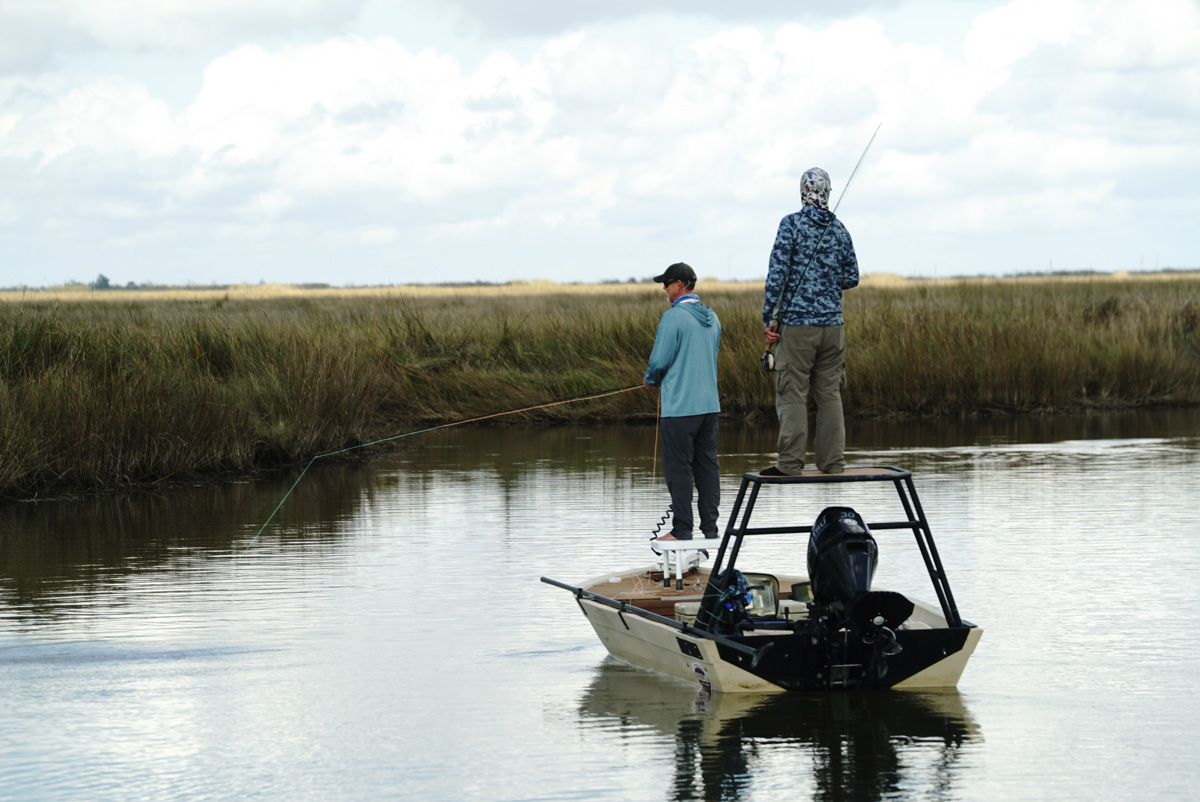 That night, a trip up the road to Houma for a new battery from an auto parts store fixed Tadpole’s trolling motor issue, and the next day we were back in business. Tadpole took the first turn atop the poling platform, and I stood on the front deck, a shiny new Sage SALT R8 in my right hand and a natural-colored shrimpy fly in the left.
That night, a trip up the road to Houma for a new battery from an auto parts store fixed Tadpole’s trolling motor issue, and the next day we were back in business. Tadpole took the first turn atop the poling platform, and I stood on the front deck, a shiny new Sage SALT R8 in my right hand and a natural-colored shrimpy fly in the left.
With the SALT R8, Sage has merged power and finesse to create a rod that meets the challenges of powerful saltwater species and the rugged environments where they’re found. Sage sent its senior designers to South Florida to work with guides and shops to develop a rod that provides strength and durability while maintaining the feel and touch necessary to deliver quick and precise shots on demand.
The added strength and durability were the easy part. Using the Revolution 8 graphite technology previously used in the company’s R8 CORE collection, Sage increased strength by about 25 percent without adding material and weight. But what separates this rod from the crowd of hefty saltwater sticks is its touch and feel, achieved by a taper and fiber alignment that delivers strength, fine-touch presentation, and an intuitive sweet spot. The rod is quick and easy to load, allowing anglers to fire off shots in the time-sensitive situations common to saltwater fly fishing.
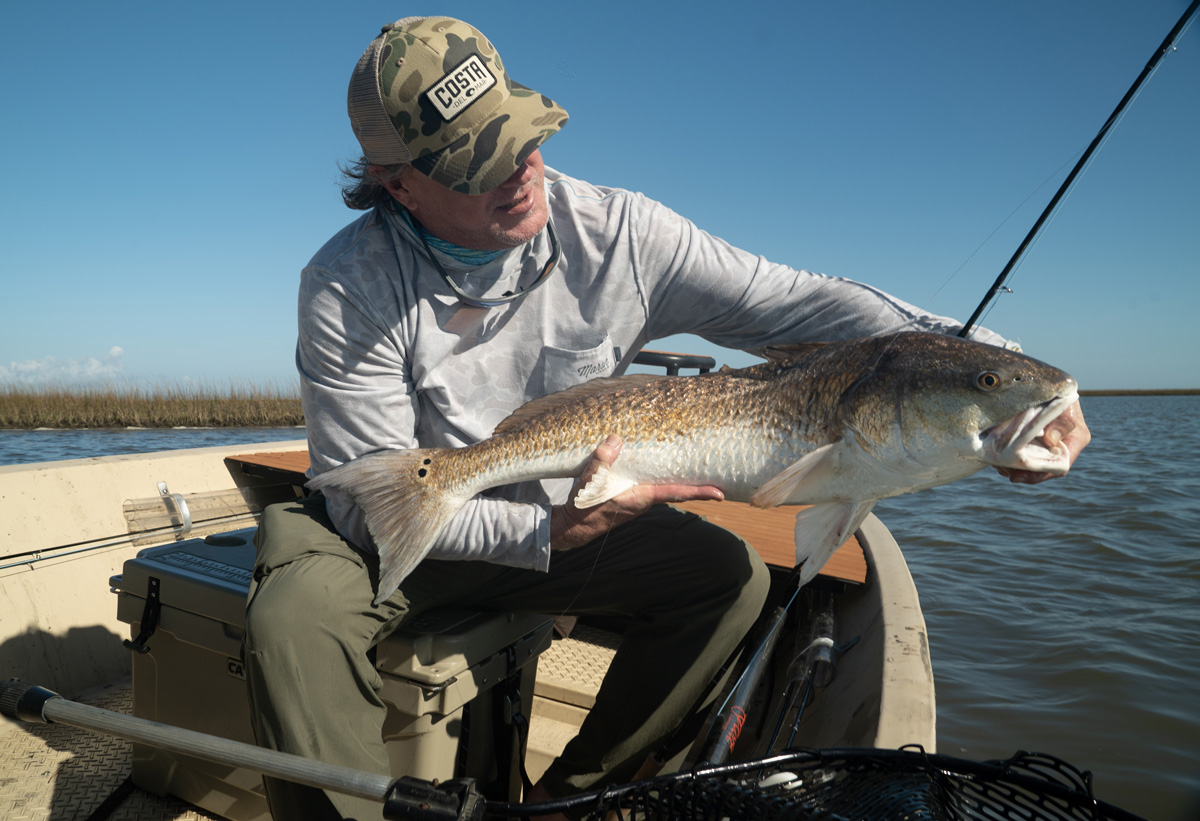 The ENFORCER completes the package. The reel’s drag is 50 percent higher than Sage’s SPECTRUM family of reels, with enlarged and improved seals, as well as design features that make it more durable in an unforgiving saltwater environment. I really like its radius-cornered reel seat, which prevents leader abrasion during storage.
The ENFORCER completes the package. The reel’s drag is 50 percent higher than Sage’s SPECTRUM family of reels, with enlarged and improved seals, as well as design features that make it more durable in an unforgiving saltwater environment. I really like its radius-cornered reel seat, which prevents leader abrasion during storage.
The rod was becoming a natural extension of my casting arm within a couple of hours of fishing on the second day in the marsh, just in time to put the rig to the test when Tadpole spotted a relaxed redfish in a foot and a half of water about 60 feet behind the skiff. He turned the skiff to give me a better shot, but the cast was into a southerly wind, and the fish was visible only as a faint silhouette in the glare. The first shot fell woefully short, and the second, more precise shot didn’t elicit a strike.
Tadpole held the boat in place. We figured the fish was likely still lurking in the area, and there might be others we hadn’t yet seen. With the limited visibility and skinny water, moving the boat could easily blow out anything in the vicinity.
Three or four minutes later, I scanned to the left and spotted a big redfish at 25 feet. The rod loaded with a quick false cast, and I dropped the fly a few inches in front of the fish. Conventional wisdom says you can hit a redfish on the head and get a strike, but this one didn’t like it. The fish didn’t spook, but it slowly swam in the opposite direction, doubling the distance between itself and the skiff before stopping again.
Two false casts sent out enough line to put the fly in front of it again at about 45 feet. With the first strip of the line, the fish turned, following the fly straight toward us before flaring its gills at 20 feet and inhaling the fly.
The big fish barely moved when I strip-set. It took a steady pull on the fly line and a slight sweep of the rod to trigger its flight response, which manifested in a water-slicing run as the big red exploded across the wide open mud flat. The SALT R8 really shined during the tug of war, making quick work of the fight time, which is good for both fish and angler. An oyster bed in the middle of the flat posed a hazard, but the sturdy 9-weight easily turned the redfish away from trouble. A few minutes later, Tadpole and I were admiring a chunky 32-inch redfish in his landing net.
Sight-fishing opportunities didn’t come easy, but when this one presented itself, the new Sage SALT R8 rod and ENFORCER reel proved up to the task. And a plan for Louisiana redfish, despite some hiccups, came together quite nicely.
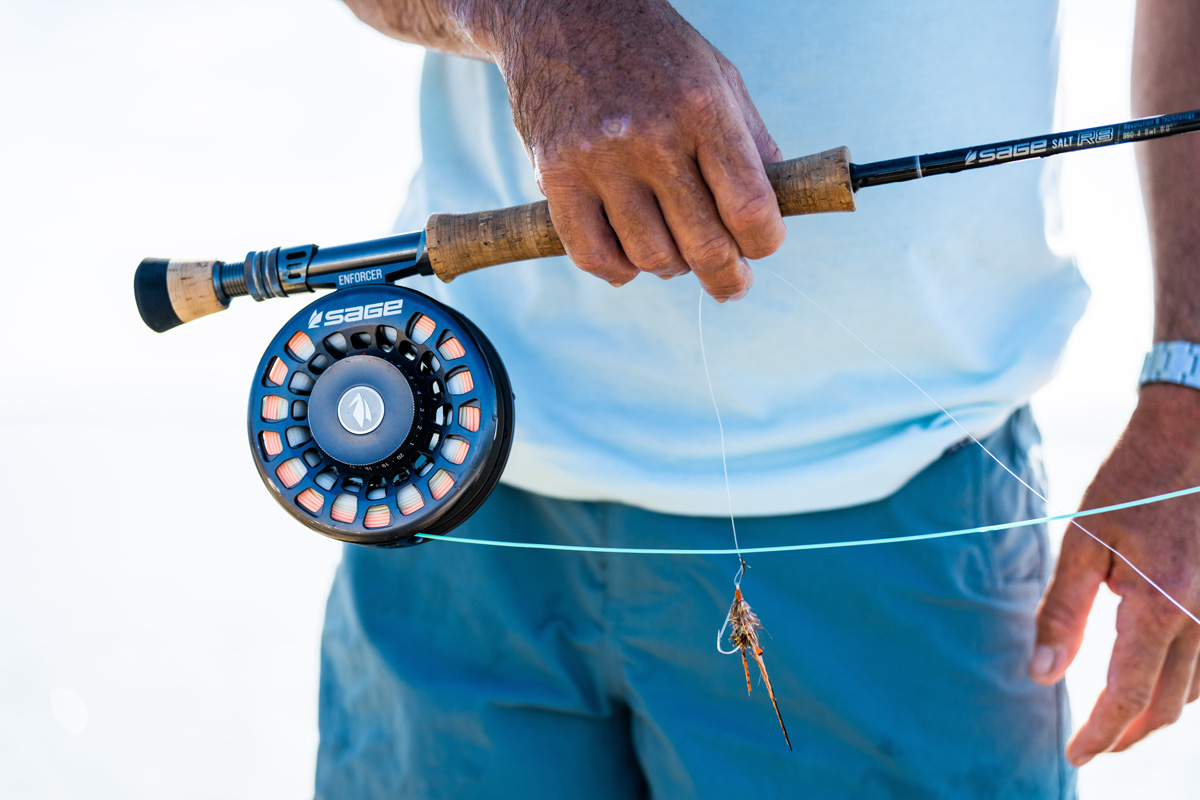
photo: Chase White


